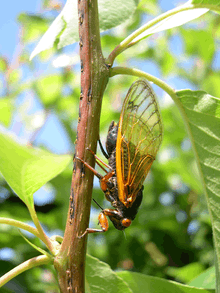Cassini periodical cicadas

The name Cassini periodical cicadas is used to group two closely related species of periodical cicadas: Magicicada cassinii (Fisher, 1852), and Magicicada tredecassini (Alexander and Moore, 1962), a species essentially identical except for its 13-year lifecycle.
Courting behavior of Cassini cicadas is unusual because large groups of males may sing and fly together in synchrony: that is, bursts of sound, as thousands of males sing in unison, alternate with silence, as clouds of flying cicadas leave perches in unison, seeking a new perch before the next ensemble song.
Description
All Magicicada species have a black dorsal thorax with red eyes and orange wing veins.[1] Cassini periodical cicadas are smaller than decim periodical cicadas. The abdomen is black except for occasional faint orange-yellow marks on the ventral surface seen in some location.
In a typical brood of periodical cicadas, decim and decula types will be present as well as cassini. The three different types have unique species song-types; they also tend to sing at different times of day, with cassini choruses most likely in mid- to late afternoon, later than decim or decula varieties.[2] The cassini-type song consists of a series of ticks followed by a buzz; it has also been described as sounding like "someone trying to get a lawnmower started."[2]
Magicicada males seek out sunlit vegetation, where they typically gather with conspecific males to form large choruses, alternating singing behavior with short flights. Cassini-type males are unusual in synchronizing these behaviors, so that thousands of males sing their mating song in unison and then fly together.[3] according to Alexander and Moore (1958):[4]
Almost every singing male in a woods containing tens of thousands of singers achieves synchrony with all the others, and the result gives the impression of a gigantic game of musical chairs. A treeful of these insects singing in synchrony is motionless when observed during the great burst of sound caused by insects buzzing together, and then becomes a frenzy of activity between buzzes with nearly every individual changing perches.
The "congregational" singing of males (so-called because it inspires both males and females to congregate) requires this synchrony in cassini-types for its success.[4]
Habitat
Periodical cicadas live in eastern United States east of the Great Plains. Cassini-type cicadas are especially common in the most southwestern populations and are the only 17-year cicada species found in Oklahoma and Texas.[3]
Cassini-type cicadas are most often found in deciduous lowland woods and flood plains, rather than the upland woods favored by other Magicicada. [3]
Ecological impact
Egg-laying by a large brood may cause many twigs to die off but does little long-term harm to mature trees.[5]
References
- ↑ "Periodical Cicada Page". University of Michigan. Retrieved 10 June 2011.
- 1 2 Carter, Janet L. Stein. "Periodical Cicadas". University of Cincinnati. Retrieved 19 June 2011.
- 1 2 3 Capinera, John L. (2008). Encyclopedia of Entomology. Springer. p. 2792. ISBN 1-4020-6242-7.
- 1 2 Alexander, Richard D.; Thomas E. Moore (1958). "Studies on the acoustical behavior of seventeen-year cicada" (PDF). Ohio Journal of Science. 32 (2): 107–127. Retrieved 20 June 2011.
- ↑ Cook, William M.; Robert D. Holt (2002). "Periodical Cicada (Magicicada cassini) Oviposition Damage: Visually Impressive yet Dynamically Irrelevant" (PDF). American Midland Naturalist. 147: 214–224. doi:10.1674/0003-0031(2002)147[0214:PCMCOD]2.0.CO;2. Archived from the original (PDF) on 7 August 2011. Retrieved 18 June 2011.
External links
- Video of Brood XIX M. tredecassini responding to the saxophone playing of David Rothenberg, 2011
- Synchronized chorusing of M. tredecassini, 2011